Why do Red Phalaropes exhibit reversed sexual dimorphism, challenging traditional avian gender roles? This question opens a window into the unique world of Red Phalaropes, a species that defies conventional expectations through its distinctive behaviors and physical characteristics.
Red Phalaropes, primarily pelagic birds found from the Arctic to the Southern Hemisphere, present an exceptional case of reversed sexual dimorphism. Unlike the typical gender roles observed in the avian domain, it is the females in this species that are larger and more brightly colored. They engage in fierce competition for mates, a behavior traditionally associated with males in the bird world. This reversal of roles not only fascinates ornithologists but also invites a broader discussion on gender roles within nature.
The vulnerability of Red Phalaropes to environmental threats, such as oil spills, further accentuates the importance of understanding their ecological role and the impact of human activities on their survival. The exploration of Red Phalaropes’ life and behaviors offers a compelling narrative on the complexities of nature and the need for conservation efforts to protect these intriguing birds and their habitats.
Key Takeaways
Key Takeaways:
- Red Phalaropes are notable for their reversed sexual dimorphism, setting them apart in the bird world.
- Their diet primarily consists of plankton, small insects, and aquatic invertebrates, showcasing their specialized feeding behaviors.
- They face significant threats from oil spills and climate change, emphasizing the urgent need for conservation efforts.
- Their existence underscores the importance of protecting marine ecosystems to maintain the balance between species adaptation and environmental pressures.
Scientific Classification
Kingdom Animalia: The Foundation of Red Phalarope’s Lineage
The Red Phalarope, nestled within the Kingdom Animalia, marks its presence in the broad and diverse family of avian species. This kingdom is a testament to the rich and complex biological tapestry to which these birds belong, showcasing their fundamental connection to the animal kingdom.
Phylum Chordata: A Vertebrate’s Blueprint
As members of the Phylum Chordata, Red Phalaropes exhibit the hallmark characteristics of vertebrates. This classification underscores the sophisticated anatomical structure that supports their unique behaviors and adaptations, particularly their flight capabilities which link them to the diverse world of birds.
Class Aves: Masters of the Sky
Within the Class Aves, these birds find their niche among the masters of the sky. This class encompasses birds of all feathers, from the smallest hummingbird to the largest ostrich, illustrating the evolutionary marvel of flight that Red Phalaropes share with their avian cousins.
Order Charadriiformes: Specialists of the Shore
The Order Charadriiformes is where we find Red Phalaropes among other shorebirds, each with its own role in the ecological balance of coastal and marine environments. This order highlights the birds’ specialized adaptations for life at the water’s edge.
Family Scolopacidae: Waders of the Waters
Belonging to the Family Scolopacidae, these birds share a common lineage with sandpipers and snipes, known for their proficiency in wading and foraging in aquatic settings. This family connection emphasizes the Red Phalarope’s adeptness in exploiting the watery landscapes for survival.
Genus Phalaropus: A Unique Trio
The Genus Phalaropus distinguishes Red Phalaropes (Phalaropus fulicarius) and their two close relatives, highlighting their distinctiveness in feeding behaviors and physical traits. This genus is a focal point for understanding the evolutionary and ecological nuances that set these birds apart from others in their family.
Through their scientific classification, from kingdom to genus, Red Phalaropes are spotlighted for their ecological and evolutionary significance, illuminating the diverse strategies that underpin their existence across varied habitats.
Habitat
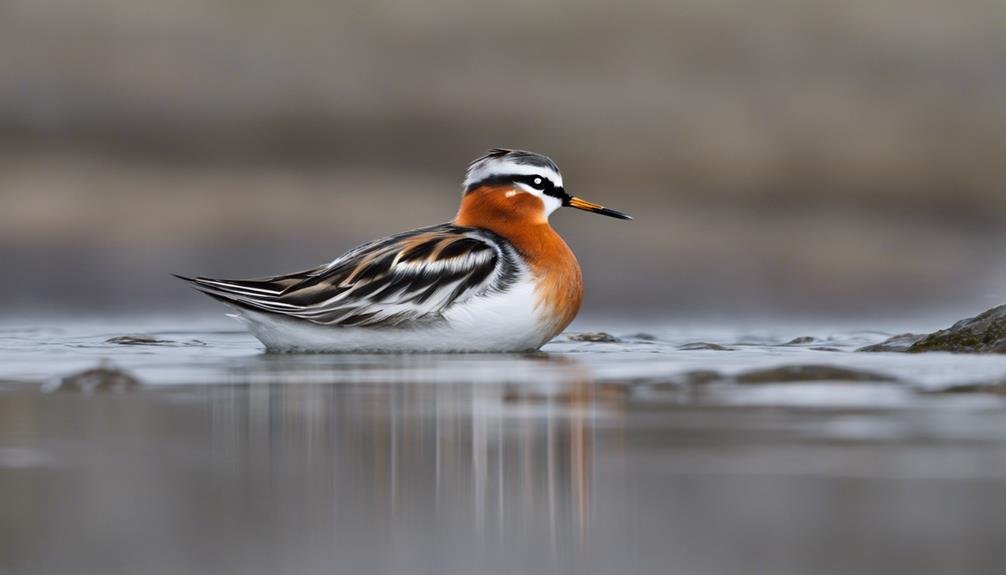
Red Phalaropes’ Open Water Habitats
Delving into the habitats of Red Phalaropes, we uncover their distinct preference for the pelagic zones – open waters that are a testament to their life adapted to the Arctic conditions and more. These birds are drawn to the expansive pelagic environments, where they’re often found far off the coastlines, embracing the vastness of the ocean. Their habitats span a broad range, making them circumpolar dwellers from the Arctic territories of the U.S. to the waters of the Southern Hemisphere. Their diverse habitats include not just the open sea but also lakes, ponds, and rivers.
In the Arctic, the chilly waters and the seasonal ice are more than just a backdrop; they’re critical for the breeding of these birds. The extreme conditions of this region demand specific survival adaptations from the Red Phalaropes. When the breeding season ends, their affinity for pelagic life shines through as they migrate towards warmer waters. This journey showcases their remarkable capabilities for long-distance flights and thriving in the open ocean, linking them intricately with aquatic ecosystems and emphasizing their role in the wider pelagic and circumpolar environments.
Diet
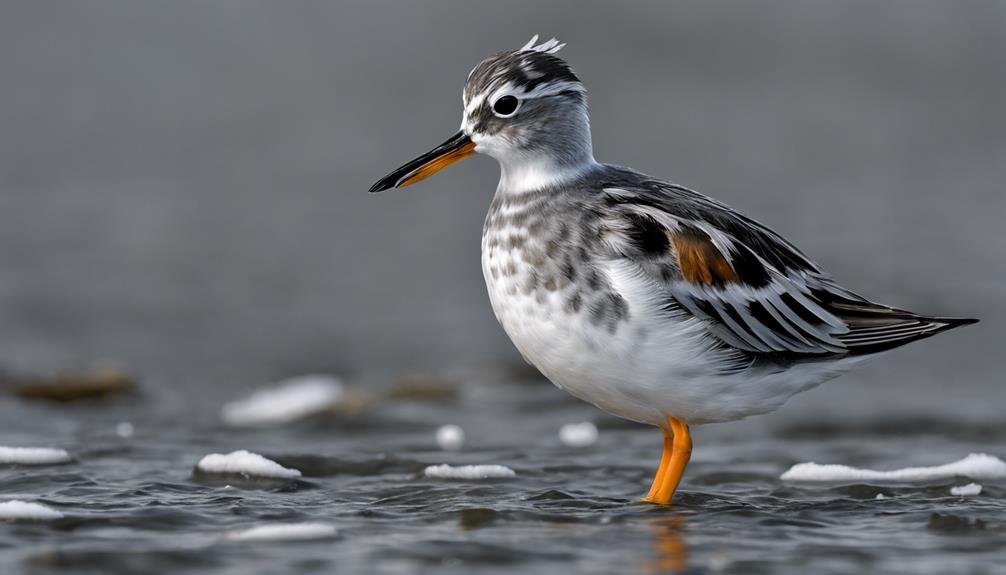
Exploring the Diet of Red Phalaropes
Diverse Dietary Choices
Red Phalaropes exhibit a fascinating adaptability in their diet, primarily focusing on plankton, small insects, and aquatic invertebrates. Their ability to thrive in the oceanic ecosystem is largely due to this diverse dietary intake, positioning them as both primary and secondary consumers within their ecological niche.
Innovative Feeding Techniques
One of the most distinctive behaviors of Red Phalaropes is their unique method of feeding. They’re known for their spinning in circles on the water surface, creating whirlpools. This ingenious strategy isn’t just a spectacle but a highly effective way to gather food. It causes their prey, including disoriented aquatic invertebrates and plankton, to be trapped by the currents and brought within reach for the Phalaropes to feed on.
Symbiotic Relationships with Marine Giants
Red Phalaropes also engage in another intriguing feeding behavior by associating with whales. They capitalize on the muddy water plumes stirred up by these large marine mammals. This action brings small fish and invertebrates to the surface, providing an accessible feast for the birds. This behavior underscores a symbiotic relationship, illustrating the interconnectedness of the marine food web and the adaptability of Red Phalaropes in exploiting available resources.
Efficiency in Nutrient Intake
A remarkable aspect of Red Phalaropes’ feeding strategy is their ability to double their body weight. This capability is a testament to the efficiency of their feeding strategies, emphasizing the critical role of their specialized diet. The rapid weight gain not only highlights their successful adaptation to their environment but also their significant role in nutrient cycling within the oceanic ecosystem.
Behaviour
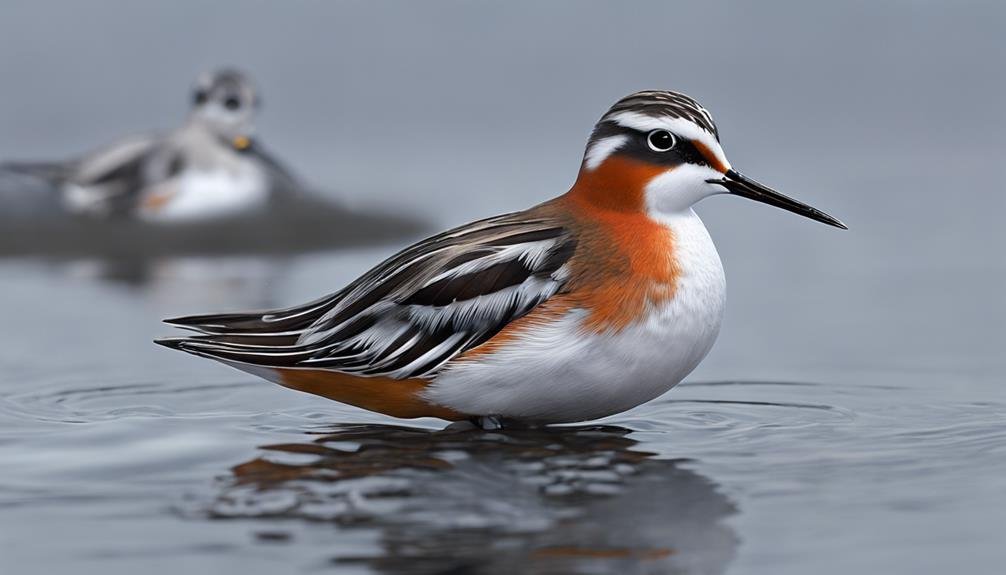
Unique Mating Rituals of Red Phalaropes
During the breeding season, Red Phalaropes stand out due to their remarkable behaviors that defy the common patterns seen in most bird species. These birds are known for their intense mating competitions and an interesting twist in gender roles. Females are the ones who take charge in both selecting nesting sites and initiating courtship, a significant departure from the norm in avian species.
Polyandry: A Distinctive Reproductive Strategy
A particularly fascinating aspect of Red Phalarope behavior is their practice of polyandry, where a single female mates with multiple males throughout the breeding season. This strategy is quite rare among birds and highlights the complex mating systems that have evolved in some species. The reversal of traditional avian sexual roles is evident not just in courtship but also in parental responsibilities.
Male Involvement in Parenting
In a complete role reversal, it’s the male Red Phalaropes that take up the mantle of nurturing the eggs and raising the young. This extends to all facets of parental care, including defending the nest from predators and feeding the hatchlings. Such behavioral adaptations showcase the evolutionary flexibility of these birds and the complex social structure that underpins their reproductive strategies.
These unique behaviors of Red Phalaropes during the breeding season illustrate the diversity and complexity of avian mating and parenting systems, providing a window into the evolutionary adaptations that have allowed these birds to thrive.
Conservation
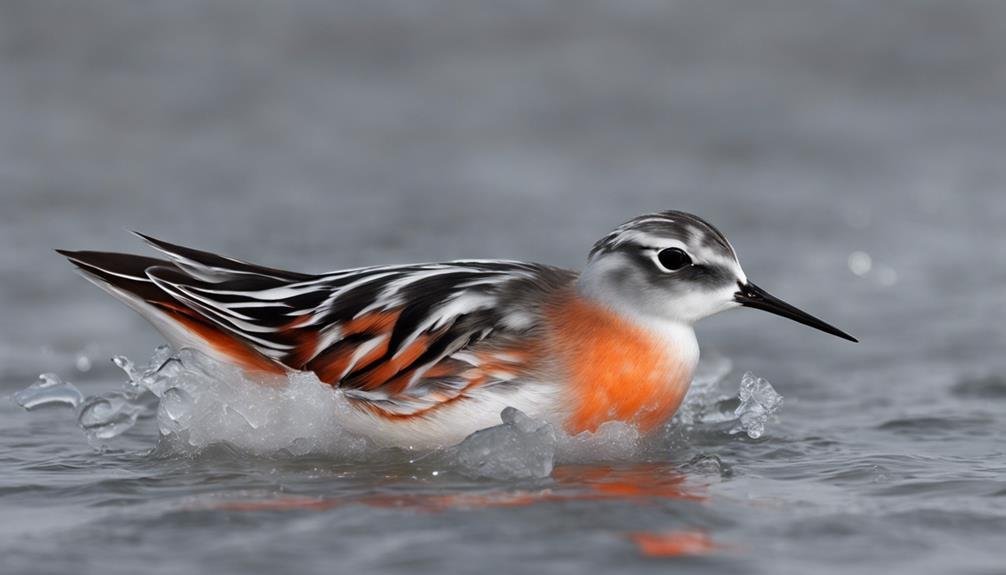
The Plight of the Red Phalarope
The Red Phalarope navigates a perilous journey throughout its migratory cycle, facing an array of threats that jeopardize its survival. Among the most pressing dangers are oil spills and habitat degradation, which pose severe risks, especially in regions where these birds gather in large numbers. The impact of oil contamination is particularly harsh, compromising the birds’ insulation and hindering their ability to forage. This predicament highlights the urgent need for concerted conservation efforts tailored to shield the Red Phalarope from such devastating consequences.
The Perils of Pollution
Aside from the threat of oil, Red Phalaropes are also at the mercy of plastic pollution. Their specialized feeding habits, finely tuned to the dynamics of certain marine ecosystems, become a liability in polluted waters. The intrusion of plastics not only diminishes food availability but also raises the specter of harmful ingestion. This convergence of challenges — from oil spills and habitat loss to plastic pollution — presents a multifaceted puzzle for conservationists dedicated to the Red Phalarope’s preservation.
Conservation Countermeasures
Addressing the threats faced by the Red Phalarope requires a multipronged approach. Protecting habitats, curbing pollution, and deploying swift responses to oil spills are paramount in this endeavor. These strategies are vital for maintaining the ecological equilibrium that the Red Phalarope relies on for survival. Through these measures, we can bolster the Red Phalarope’s defenses against the relentless tide of environmental and anthropogenic hazards, ensuring a fighting chance for this remarkable species.
Climate Change Impacts
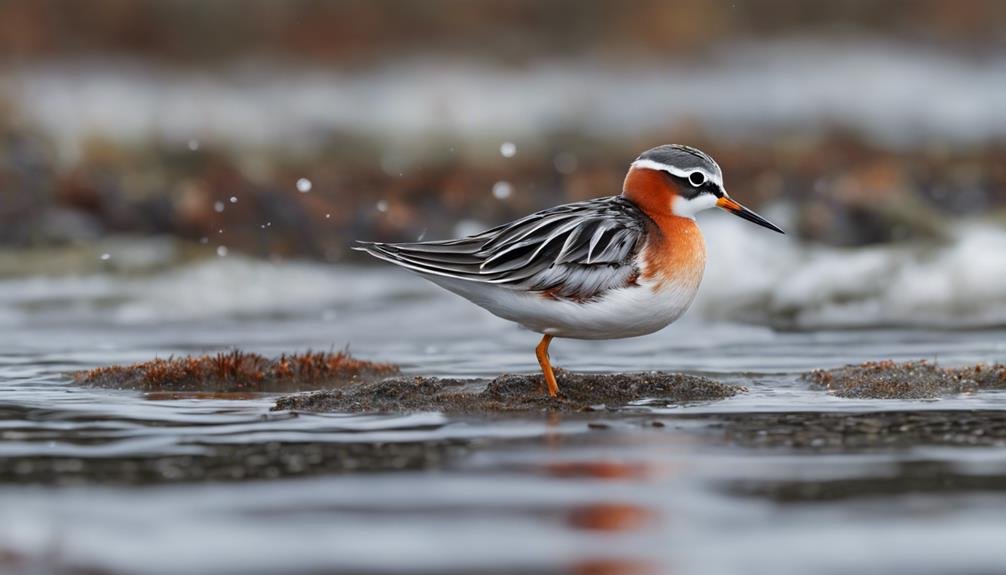
Habitat Transformation in the Arctic
The Arctic breeding grounds of the Red Phalaropes are witnessing dramatic changes. The ongoing warming trends are significantly altering the landscape, leading to a reduction in suitable nesting and breeding habitats. This degradation is a direct consequence of rising temperatures, which not only affect the physical environment but also disrupt the food chains that these birds rely on during their breeding season.
Ocean Ecosystem Changes
The wintering habitats of Red Phalaropes in oceanic regions are facing severe challenges due to changing ocean conditions. These changes are impacting the availability of food resources and the overall quality of their marine habitats. The alterations in sea temperature and currents are reshaping the ecosystems that support a myriad of marine life, including the prey species of Red Phalaropes.
Geographical Distribution Shifts
Projected climate maps suggest a worrying trend for Red Phalaropes, with potential shifts in their geographical range. This phenomenon forces the species to migrate to new areas, which may lack the essential resources for their survival. These shifts not only pose a challenge for the species to adapt but also for conservation efforts to keep pace with their changing distribution patterns.
Impact of Global Temperature Rise
The overarching issue of global temperature rise is disturbing the delicate balance of ecosystems crucial for the Red Phalaropes. These ecosystems provide vital breeding, feeding, and migratory pathways for the species. As temperatures climb, the synchronicity between the timing of food availability and the breeding season may be disrupted, affecting the survival rates of chicks and the reproductive success of the species.
Population Trends
Recent research links the decline in Red Phalarope populations directly to the adverse effects of climate change. These studies highlight the urgency of implementing effective conservation measures aimed at mitigating the impacts of habitat loss, altered ocean conditions, and range shifts. The conservation strategies need to be adaptive and robust to safeguard the future of Red Phalaropes in a changing climate.
Other Interesting Facts

Breeding Behaviors of Red Phalaropes
Red Phalaropes stand out for their intriguing breeding practices, where gender roles are flipped in comparison to most bird species. Female phalaropes are the ones engaging in competition for mates, showcasing aggressive behaviors during mating seasons. This rare occurrence highlights the females’ quest for multiple partners, contrary to the often passive role seen in other avian counterparts. The females’ striking appearance, with rusty underparts, a white ear patch, and a yellow bill, sets them apart from the males, who exhibit more muted color schemes.
Feeding Strategies and Symbiotic Relationships
Another aspect of Red Phalaropes that captures attention is their unique feeding behavior. They’re often found in the vicinity of gray and bowhead whales, utilizing the disturbed waters caused by these massive creatures to catch their prey. This interaction between Red Phalaropes and whales, observed by whalers who dubbed them ‘bowhead birds’, underscores a fascinating symbiotic relationship where both species benefit from each other’s presence.
Longevity and Survival
A testament to their resilience and adaptive strategies is the longevity of the Red Phalarope species. The oldest known male Red Phalarope lived to be at least eight years old. This durability reflects not only their robust survival tactics amidst challenging environments but also the success of their unique breeding and feeding habits in sustaining their populations.
What is the Relationship Between Red Phalaropes and Ringed Seals in their Ecosystem?
Red Phalaropes are known to have a significant relationship with ringed seals in their ecosystem. These small birds feed on zooplankton and small fish found in areas with high ringed seal populations. They are often observed foraging near the ice edges where ringed seals breed and give birth. For more ringed seal information page, visit our website.
Frequently Asked Questions
What Do Red Phalarope Eat?
What do Red Phalaropes eat?
Red Phalaropes primarily feed on plankton, aquatic insects, and small crustaceans. They use distinctive ocean foraging methods, including creating whirlpools, to capture their prey. This diet is vital for their survival, particularly during the mating and breeding seasons.
How Big Are Red Phalaropes?
Q: How big are Red Phalaropes?
A: Red Phalaropes measure between 8 to 9 inches in length. This size is particularly advantageous for their aquatic lifestyle, impacting their breeding displays, migration, nesting behavior, social interactions, vocalizations, and life expectancy.
Are Red Phalarope Endangered?
Are Red Phalaropes Endangered?
Q: Is the Red Phalarope species considered endangered?
A: No, Red Phalaropes are not classified as endangered. They have a stable population thanks to effective conservation measures, which include habitat protection, successful breeding strategies, and legal actions to mitigate migration issues. These efforts ensure their survival without the pressing threat of endangerment.
Where Are Red Phalaropes Found?
Q: Where can you find Red Phalaropes?
A: Red Phalaropes are found globally, migrating from their Arctic breeding grounds to Southern Hemisphere waters. They prefer open waters for feeding and can be observed in conservation areas during their seasonal movements.
Are There Any Similar Behaviors Between the Red Phalarope and the Hoary Redpoll?
Both the red phalarope and the hoary redpoll exhibit fascinating migratory behaviors. The red phalarope migrates between polar and tropical regions, while the hoary redpoll navigates Arctic winters. Interestingly, hoary redpoll bird facts reveal their resilience in extreme cold, much like the red phalarope’s adaptability in varying climates.
Do Red Phalaropes Rely on Cotton Grass in Their Habitat?
Red Phalaropes, seabirds known for their migratory patterns, often rely on Arctic wetlands for breeding. These wetlands commonly feature the cotton grass plant species, which plays a crucial role in sustaining the ecosystem by providing cover and supporting insect populations, an essential part of the birds’ diet during certain seasons.
What Adaptations Help the Red Phalarope Survive in Harsh Arctic Environments?
The red phalarope thrives in the harsh Arctic through several adaptations, including a thick plumage for insulation and specialized feeding habits. Unlike many birds, it swims to catch plankton. These survival strategies parallel arctic fox adaptations, such as their fur for warmth and resourceful hunting techniques in extreme cold.
Conclusion
Summarizing the key insights about Red Phalaropes, it’s evident that their distinct reversed sexual dimorphism and specialized feeding behaviors set them apart in the avian world.
Inhabiting pelagic zones that stretch from the Arctic to the Southern Hemisphere, their diet is rich in plankton, small insects, and aquatic invertebrates.
Yet, despite their remarkable adaptability, they confront serious challenges from oil spills and climate change. These threats highlight the pressing need for dedicated conservation efforts to ensure their survival.
The existence of Red Phalaropes serves as a poignant reminder of the delicate balance between species adaptation and environmental pressures, underscoring the critical role of protecting marine ecosystems.


